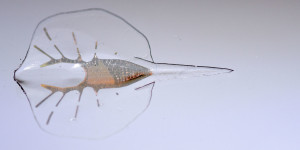
This tiny stingray-like biological robot hold a wealth of possibilities for robotics as well as medicine. Image Karaghen Hudson and Michael Rosnach
Scientists from Harvard University have found a way to create a tiny biological robot using some genetic engineering knowhow, some gold, some silicon, and a couple hundred thousand rat heart cells.
This “living” robot looks, swims and flexes like a stingray and has truly impressed the researchers. Its skeletal system is made up of gold wire which is insulated by a layer of silicone. A silicone substrate forms its overall body and is mixed with 200,000 genetically engineered rat heart cells, Engadget reports.
To get the bio-bot to move, they expose it to a certain light wavelength. This causes it to undulate and swim like a stingray as well as follow the light source. Right now, the little ‘stingray-bot’ swims in a special nutrient-rich liquid to keep the rat cells alive. It would not survive in any other liquid for long as it does not have an immune system yet and would fall pray to bacteria and fungal pathogens.
Lead researcher Kit Parker said, “Roboticists and engineers can see different ways to use biological cells as building materials. Marine biologists can take a look to better understand why the muscle tissues in rays are built and organized the way they are.”
Furthering the research may also lead to making better artificial hearts and possibly other organs. Alfred Bayle